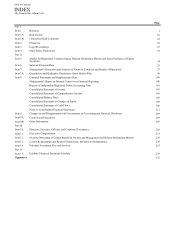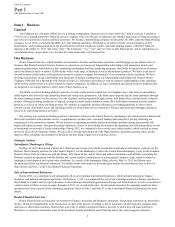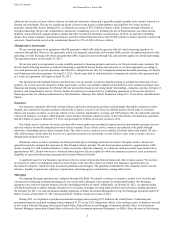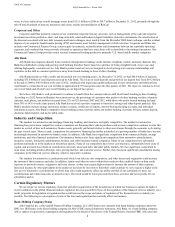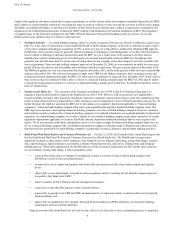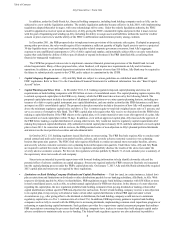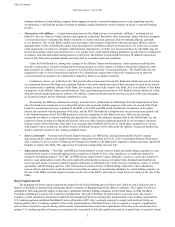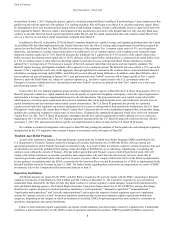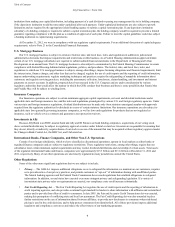Ally Bank 2012 Annual Report Download - page 10
Download and view the complete annual report
Please find page 10 of the 2012 Ally Bank annual report below. You can navigate through the pages in the report by either clicking on the pages listed below, or by using the keyword search tool below to find specific information within the annual report.8
no later than October 1, 2013. During this period, capital is calculated using both Basel I and Basel II methodologies. Upon completion of this
parallel run and with the approval of the primary U.S. banking regulator, Ally will begin to use Basel II to calculate regulatory capital. Basel
II contemplated a three-year transition period during which a bank holding company or bank could gradually lower its capital level below the
levels required by Basel I. However, under a final capital rule that implements a provision of the Dodd-Frank Act, Ally and Ally Bank must
continue to calculate their risk-based capital requirements under Basel I, and the capital requirements that each computes under Basel I will
serve as a floor for its risk-based capital requirement computed under Basel II.
In addition to Basel II, in December 2010, the Basel Committee adopted new capital, leverage, and liquidity guidelines under the Capital
Accord (Basel III) that when implemented in the United States may have the effect of raising capital requirements beyond those required by
current law and the Dodd-Frank Act. Basel III calls for an increase of the minimum Tier 1 common equity ratio to 4.5%, net of regulatory
deductions, and introduces a capital conservation buffer of an additional 2.5% of common equity to risk-weighted assets raising the target
minimum common equity ratio to 7.0%. Basel III increases the minimum Tier 1 capital ratio to 8.5% inclusive of the capital conservation
buffer, increases the minimum total capital ratio to 10.5% inclusive of the capital buffer, and introduces a countercyclical capital buffer of up
to 2.5% of common equity or other fully loss absorbing capital for periods of excess credit growth. Basel III also introduces a nonrisk
adjusted Tier 1 leverage ratio of 3%, based on a measure of the total exposure rather than total assets, and new liquidity standards. The
Basel III capital, leverage, and liquidity standards will be phased in over a multiyear period. The Basel III rules also call for a 15% cap on the
amount of Tier 1 capital that can be met, in the aggregate, through significant investments in the common shares of unconsolidated financial
subsidiaries, mortgage servicing rights (MSRs), and deferred tax assets through timing differences. In addition, under Basel III rules, after a
ten-year phase-out period beginning in January 2013, trust preferred and other "hybrid" securities will no longer qualify as Tier 1 capital.
However, under the Dodd-Frank Act, subject to certain exceptions (e.g., for debt or equity issued to the U.S. government under the
Emergency Economic Stabilization Act), trust preferred and other "hybrid" securities are phased out from Tier 1 capital over a three-year
period starting January 2013.
In June 2012, the U.S. banking regulators proposed rules to implement many aspects of Basel III (the U.S. Basel III proposals). The U.S.
Basel III proposals contain new capital standards that raise the quality of capital and strengthen counterparty credit risk capital requirements
and introduce a leverage ratio as a supplemental measure to the risk-based ratio. The proposals include a new capital conservation buffer,
which imposes a common equity requirement above the new minimum that can be depleted under stress, and could result in restrictions on
capital distributions and discretionary bonuses under certain circumstances. The U.S. Basel III proposals also provide for a potential
countercyclical buffer that regulators can activate during periods of excessive credit growth in their jurisdiction. Furthermore, the U.S. Basel
III proposals would replace the current Basel I-based "capital floor" (discussed above) with a standardized approach that, among other things,
modifies the existing risk weights for certain types of asset classes. If adopted, this standardized approach would serve as the new minimum
"capital floor" for Ally. The U.S. Basel III proposals contemplate that the new capital requirements would be phased in over several years,
beginning in 2013. In November 2012, the U.S. banking regulators announced that the U.S. Basel III proposals would not become effective
on January 1, 2013. The announcement did not specify new implementation or phase in dates for the U.S. Basel III proposals.
We continue to monitor developments with respect to Basel III and, pending the adoption of final capital rules and subsequent regulatory
interpretation by the U.S. regulators, there remains a degree of uncertainty on the full impact of Basel III.
Troubled Asset Relief Program
As part of the Automotive Industry Financing Program created under the Troubled Asset Relief Program (TARP) established by the
U.S. Department of Treasury (Treasury) under the Emergency Economic Stabilization Act of 2008 (the EESA), Ally has entered into
agreements pursuant to which Treasury has made investments in Ally. As a result of these investments, subject to certain exceptions, Ally and
its subsidiaries are generally prohibited from paying certain dividends or distributions on, or redeeming, repurchasing, or acquiring any
common stock without the consent of Treasury. Ally has further agreed that until Treasury ceases to hold Ally preferred stock, Ally will
comply with certain restrictions on executive perquisites and compensation. Ally must also take all necessary action to ensure that its
corporate governance and benefit plans with respect to its senior executive officers comply with Section 111(b) of the EESA as implemented
by any guidance or regulation under the EESA, as amended by the American Recovery and Reinvestment Act of 2009, as implemented by the
Interim Final Rule issued by Treasury on June 15, 2009. For further details regarding these restrictions on compensation as a result of TARP
investments, refer to the Compensation Discussion and Analysis in Item 11.
Depository Institutions
Ally Bank's deposits are insured by the FDIC, and Ally Bank is required to file periodic reports with the FDIC concerning its financial
condition. Total assets of Ally Bank were $94.8 billion and $85.3 billion at December 31, 2012 and 2011, respectively. As a commercial
nonmember bank chartered by the State of Utah, Ally Bank is subject to various regulatory capital adequacy requirements administered by
state and federal banking agencies. The Federal Deposit Insurance Corporation Improvement Act of 1991 (FDICIA), among other things,
identifies five capital categories for insured depository institutions ("well-capitalized," "adequately capitalized," "undercapitalized,"
"significantly undercapitalized," and "critically undercapitalized") and requires the respective federal regulatory agencies to implement
systems for "prompt corrective action" for insured depository institutions that do not meet minimum capital requirements within such
categories. Depending on the category in which an institution is classified, FDICIA imposes progressively more restrictive constraints on
operations, management, and capital distributions.
Failure to meet minimum capital requirements can initiate certain mandatory and discretionary actions by regulators that, if undertaken,
could have a direct material effect on Ally Bank's results of operations and financial condition. FDICIA generally prohibits a depository
Table of Contents
Ally Financial Inc. • Form 10-K


